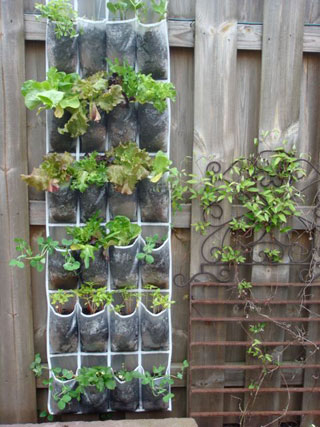






By Monique Watts for Artvoice
In the spirit of Jack’s magical beanstalk adventures, gardeners are hanging tomatoes upside down, sending climbing vines up found architectural treasures and creating edible tables and walls in even the most restrictive spaces. By planning your space with color, texture, sound, smell, and taste in mind, you can create an oasis on even the smallest apartment balcony or cramped backyard. But to make the most out of your space, you may need to look up.
When it comes to vegetables, planting succession beds and companion crops can expand the yield. For example, choose vegetables with a short ripening time for your first cycle followed by late harvest crops once the first round is harvested. Lettuces can be planted in front of tomatoes, followed by broccoli or carrots that can mature before winter. Beans, tomatoes, melons, and squashes can all be trained to grow up trellises, strings, poles and other structures that will not only maximizes the space but creates interesting visual landscape aspects.
Liz Lipsitz, local gardening expert at Urban Roots Community Garden Center, sees a trend in vertical gardening. “As more residential spaces are created downtown, we will see vertical and rooftop gardening become more prevalent,” says Lipsitz. Lipsitz is far from being a minimalist gardener; she believes in growing as many plant species, especially native plants, as can thrive in the confines of her North Buffalo yard. “The benefits of planting a garden wall or green roof,” she says, “is that it can cut down on heating and cooling of a home and it can redirect rain water into a living structure rather than into our water tables.”
Commercially built planting structures complete with automatic watering systems are available, but Liz suggests using items that can be found around your own home or neighborhood. A wall of stacked cinder blocks can be backed with plastic or landscape fabric to hold in the soil. These can then be planted with herbs, annuals or vegetables. A canvas shoe holder, lined with landscape fabric or cocoa liners, can house an edible garden of lettuces, nasturtium, pansy, and strawberries right on your patio fence. In addition to limited weeding, these hanging gardens are safe from grubs.
For a really industrious vertical garden project, view the wall design and step by step instructions by Alyssa, a gardener in Washington State, at http://www.lushe.com.au/2009/12/08/how-to-build-a-vertical-garden-2/.
There is a garden design to fit any space challenges, be it an alleyway lined with colorful pots of shade-loving hostas, pockets of woodland plants in an old brick wall, or even an open-air atrium transformed into a summer dining room. Take pictures of the site and talk with your local nursery or garden center to get ideas about how to transform it into a place of tranquility and functionality.
Read more: http://artvoice.com/issues/v9n18/the_hanging_garden#ixzz10vsxHyv2
Copyright © www.100flowers.win Botanic Garden All Rights Reserved